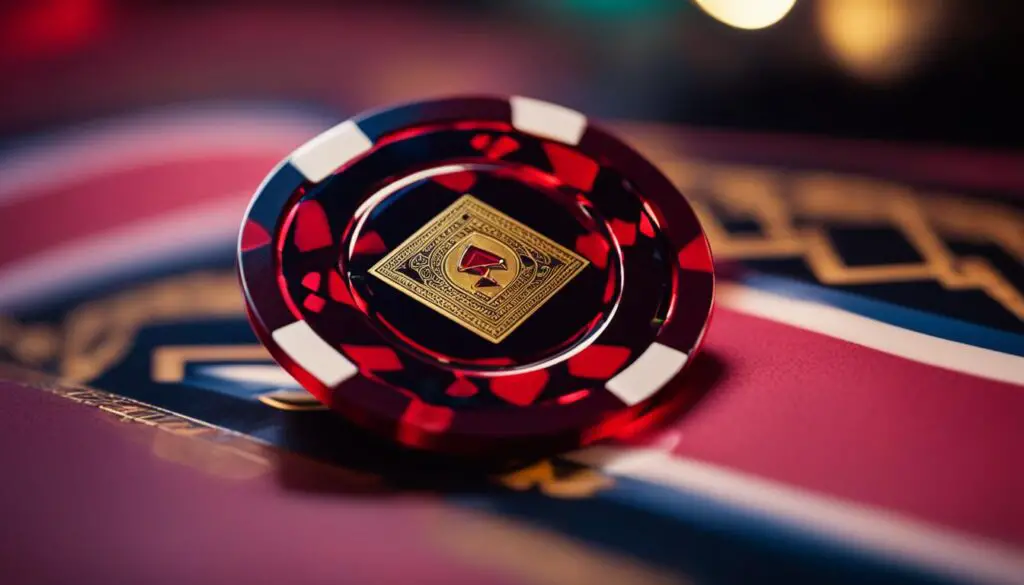Have you ever wondered why poker players place a chip on their cards during a game? It turns out that there’s more to it than meets the eye. This common practice among poker players serves multiple purposes, from protecting their cards to influencing their opponents. Let’s dive into the secrets behind this intriguing strategy.
When poker players place a chip on their cards, it acts as a card protector. This small but mighty chip prevents their cards from accidentally being exposed or discarded by the dealer. It serves as a physical barrier, ensuring that their hand remains intact and playable. Players who use a chip as a card protector emphasize the importance of their hand, signaling to their opponents that they are serious contenders at the table.
Additionally, placing a chip on their cards allows players to keep track of their position and the strength of their hand. It serves as a visual reminder, helping them make informed decisions as the game progresses. But the chip placement goes beyond functionality; it is also a psychological tactic. By intimidating opponents and exuding confidence, players aim to gain an edge in the game.
Key Takeaways:
- Poker players place a chip on their cards as a card protector, preventing accidental exposure or discarding.
- Using a chip on their cards helps players keep track of their position and the strength of their hand.
- Chip placement serves as a psychological tactic to intimidate opponents and create a sense of confidence.
- It can also be a strategic move to influence the betting actions of other players.
- The secrets of chip placement go beyond card protection, with subtle nuances conveying additional information to observant opponents.
The Significance of Chip Placement in Poker
Chip placement in poker holds great significance and serves multiple purposes during gameplay. Players strategically place chips on their cards to convey important information about their hand and intentions. It is a subtle form of communication that can give players an advantage over their opponents.
When a player places a chip on their cards, it typically indicates that they have a strong hand and are confident in their ability to win the pot. This placement can influence the actions of other players, controlling the flow of the game and potentially manipulating the betting rounds.
Additionally, the position and orientation of the chip on the cards can reveal additional information to observant opponents. Placing the chip closer to the center of the cards often signifies a stronger hand, while placing it closer to the edge may suggest a weaker hand or a bluff. The angle or tilt of the chip can also convey valuable information, such as confidence or uncertainty.
Reasons for Placing a Chip on Cards:
- Protection: Placing a chip on cards acts as a card protector, preventing accidental exposure or mucking by the dealer.
- Signaling Strength: It signifies that a player’s hand is still in play and is considered important.
- Psychological Tactics: Chip placement can be used as a strategy to intimidate opponents, create confidence, and gain a psychological edge.
- Strategic Manipulation: By strategically placing a chip on their cards, players can influence the actions of their opponents and manipulate the betting rounds to their advantage.
The Strategy Behind Chip Placement in Poker
In the game of poker, chip placement is not just a random act but a strategic move that can have a significant impact on the outcome of a hand. The purpose of placing a chip on one’s cards goes beyond mere card protection; it is a tactic that can be used to deceive opponents and manipulate the flow of the game.
One strategy behind chip placement is to visually establish dominance and control over the pot. By placing a chip on their cards, players create a physical barrier that separates their hand from the rest of the table, ensuring that it remains protected. This act of card protection can also serve as a form of deception, as opponents may perceive a player’s hand as stronger than it actually is.
Furthermore, chip placement can influence the betting actions of other players. By strategically placing a chip on their cards, a player can encourage or discourage certain bets, manipulate the pot size, and potentially force their opponents into making suboptimal decisions. The angle or tilt of the chip can also convey valuable information. A chip tilted towards the player typically signifies confidence, while a chip tilted away may indicate uncertainty or deception.

Mastering the strategy behind chip placement in poker requires a keen understanding of both the psychological aspects of the game and strategic gameplay. It is not merely a matter of protecting one’s cards but a means of asserting dominance, manipulating opponents, and gaining an edge at the table. By utilizing chip placement effectively, players can elevate their game and increase their chances of success in the high-stakes world of poker.
Poker Card Protector Chip: A Player’s Best Friend
A poker card protector chip is an essential tool that every serious poker player should have at the table. This small but powerful item serves as a physical barrier, ensuring that a player’s hand remains protected from accidental exposure or unwanted interference. Placed on top of the player’s hole cards, the card protector chip emphasizes the importance of the hand and acts as a symbol of commitment.
Not only does the card protector chip serve a functional purpose, but it also has a psychological impact on the game. It can be a lucky charm or a personal signature, reflecting the player’s personality and style. The presence of a card protector chip can also create a sense of intimidation among opponents, conveying the message that the player means business and is ready to take down the pot.
Furthermore, the poker card protector chip can serve as a conversation starter and a way to connect with other players at the table. It is a common practice for players to have unique and customized card protector chips, adding a personal touch to their gameplay. This small item holds great significance in the poker world, representing the dedication and passion that players have for the game.
The Secrets of Chip Placement Revealed
In the game of poker, chip placement goes beyond mere card protection. The position and orientation of a chip on a player’s cards can communicate valuable information to observant opponents. Placing the chip closer to the center of the cards typically signifies a stronger hand, while placing it closer to the edge may suggest a weaker hand or a bluff. This strategic placement can be used to mislead opponents and gain an edge in the game.
The angle or tilt of the chip also holds significance. A chip tilted towards the player often conveys confidence, while a chip tilted away may indicate uncertainty or deception. These subtle nuances in chip placement can be utilized as strategic tools to influence the perceptions and decisions of opponents.
By mastering chip placement techniques, skilled poker players can effectively control the flow of the game and manipulate their opponents. They can use chip placement as a means to assert dominance, intimidate opponents, and create a psychological advantage. Understanding the secrets of chip placement in poker is an essential skill that can greatly enhance a player’s overall strategy and potential for success.

Keep in mind that chip placement is just one aspect of mastering the art of poker. It is important to combine chip placement with other valuable skills, such as reading poker tells and understanding opponents’ betting patterns. By honing these skills, players can gain a deeper understanding of the game and make more informed decisions.
The Impact of Chip Placement in Live Poker
In live poker, the way players place their chips on their cards can have a significant impact on the dynamics of the game. The strategic placement of chips serves as a visual cue that can attract attention and create a sense of anticipation among other players at the table. It signals that the player has a strong hand and is confident in their ability to win the pot. This can influence the betting patterns of opponents and potentially cause them to make suboptimal decisions.
Moreover, chip placement on cards can contribute to the overall atmosphere of the game. It adds an element of suspense and intensity, making the experience more thrilling for all players involved. By strategically placing their chips on their cards, players can assert dominance and control over the table, creating a psychological pressure on their opponents.
Additionally, the way chips are placed on cards can also convey valuable information about a player’s intentions and hand strength. Observant opponents may pay close attention to the position and orientation of the chips, trying to interpret the subtle cues. Placing chips closer to the center of the cards typically indicates a stronger hand, while placing them closer to the edge may suggest a weaker hand or a bluff. The angle or tilt of the chips can also reveal insights into a player’s confidence or uncertainty. These subtle details in chip placement can be used to mislead opponents and gain an edge in the game.
In summary, chip placement in live poker has a profound impact on the game. It attracts attention, creates anticipation, and influences the betting patterns of opponents. The strategic positioning of the chips can convey important information about a player’s hand strength and intentions. By mastering the art of chip placement, players can enhance their gameplay and increase their chances of success at the poker table.
The Art of Chip Placement: Mastering Poker Tells
Mastering poker tells is a crucial skill that sets great players apart from the rest. One of the key elements of reading an opponent’s intentions lies in their chip placement. The way a player positions their chips on the table can reveal important insights into their hand strength, level of confidence, and overall strategy.
Interpreting poker tells through chip placement requires careful observation and analysis. A player who places their chips delicately and confidently on their cards is likely indicating a strong hand. On the other hand, if a player’s chips are haphazardly scattered or placed with hesitation, it may indicate a weaker hand or a bluff.
The art of chip placement goes beyond just the physical act. It involves paying attention to the subtleties, such as the angle and orientation of the chip. A chip tilted towards the player can signify confidence, while a chip tilted away might suggest uncertainty or deception. By honing these skills, players can use chip placement as a powerful psychological tool to manipulate the dynamics of the table and gain an edge over their opponents.
Understanding and mastering poker tells, including chip placement, is a lifelong endeavor. It requires practice, keen observation, and a deep understanding of human behavior. By developing this skill, players can enhance their ability to read opponents, make calculated decisions, and ultimately increase their chances of success at the poker table.
FAQ
Why do poker players put a chip on their cards?
Poker players place a chip on their cards as a form of protection and to signify that their hand is still in play. It acts as a card protector, preventing their cards from being accidentally exposed or mucked by the dealer.
What is the significance of chip placement in poker?
Chip placement can convey important information about a player’s hand and intentions. It can indicate a strong hand and confidence, serve as a subtle form of communication, manipulate betting rounds, and influence the actions of other players.
What is the strategy behind chip placement in poker?
The strategy behind chip placement involves psychological tactics and strategic gameplay. It allows players to establish dominance, visually control the pot, deceive opponents, and manipulate the betting actions of other players to gain an advantage.
What is a poker card protector chip?
A poker card protector chip is a player’s best friend at the poker table. It serves as a physical barrier to protect their hand from accidental exposure or interference. It also acts as a symbolic representation of the player’s commitment to their hand and can reflect their personality and style.
What are the secrets of chip placement in poker?
Chip placement goes beyond card protection. The position, orientation, and angle of the chip can convey additional information to observant opponents. It can be used to mislead opponents, create anticipation, and exert psychological pressure to gain an edge in the game.
What is the impact of chip placement in live poker?
Chip placement in live poker can attract attention and create a sense of anticipation among other players. It can influence betting patterns, level of intimidation, and psychological pressure on opponents, potentially leading them to make suboptimal decisions.
How does chip placement relate to mastering poker tells?
Chip placement is an essential skill for mastering poker tells. It reveals valuable information about hand strength, confidence, and intentions, allowing players to adjust their strategies accordingly. Effective chip placement can be used as a powerful psychological tool to gain an advantage over opponents.
